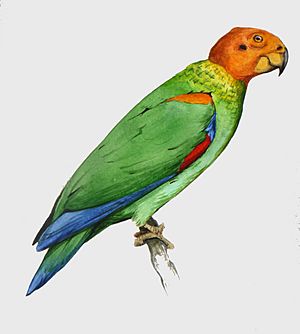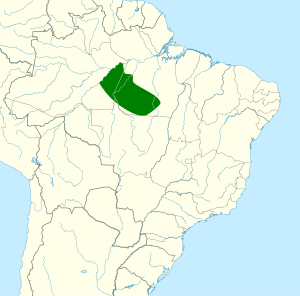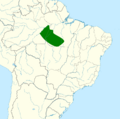Bald parrot facts for kids
Quick facts for kids Bald parrot |
|
|---|---|
 |
|
| Bald parrot (Pyrilia aurantiocephala) | |
| Conservation status | |
| Scientific classification | |
| Genus: |
Pyrilia
|
| Species: |
aurantiocephala
|
 |
|
| Synonyms | |
|
|
The bald parrot (also called the orange-headed parrot) is a unique type of parrot. Its scientific name is Pyrilia aurantiocephala. This bird lives only in the east-central Amazon rainforest in Brazil. It prefers to live in warm, wet lowland forests. Sadly, the bald parrot is considered near threatened. This is because many trees in the Amazon are being cut down, which destroys their home.
Contents
About the Bald Parrot
The bald parrot is a medium-sized bird. It is mostly green, but its head is bare and brownish-orange. This bare, colorful head is how it got its name!
Like some other parrots in its group (called Pyrilia), it has red feathers under its wings. You can barely see these red feathers when the parrot is sitting. But when it flies, they are very easy to spot.
What do they sound like?
Bald parrots communicate using special sounds. They make a high-pitched "skee-skee-skee" noise. They also make a rolling, slightly nasal sound like "chow-chow-chow".
What do they eat?
These parrots enjoy a varied diet. They eat flowers, seeds, fruits, and even insects.
Discovery of a New Species
For a long time, people thought the bald parrot was just a young vulturine parrot. This was because young vulturine parrots also have orange heads. However, vulturine parrots have black heads when they grow up.
In 1999, Brazilian scientists went to the Amazon to study parrots. They found many orange-headed parrots that were already grown up. These adult birds were not flying with vulturine parrots. Instead, they formed their own groups.
This discovery showed that these birds were not young vulturine parrots. They were a completely new species! So, in 2002, scientists officially named this new parrot Pyrilia aurantiocephala.
Where Bald Parrots Live
Bald parrots live in the humid, tropical lowlands of central Brazil. You can find them near the Lower Madeira River, the Upper Tapajós River, and the Teles Pires River. These areas are part of their natural forest home.
Protecting the Bald Parrot
The bald parrot often flies with other parrot species. Scientists estimate there are about 6,700 adult bald parrots in the wild. The total population, including younger birds, is estimated to be around 10,000.
However, this number is decreasing. It is becoming harder to spot these beautiful birds. The main reason for this decline is deforestation. When forests are cut down, the bald parrots lose their homes and food sources. Protecting the Amazon rainforest is very important for the survival of these unique birds.
Images for kids
See also
 In Spanish: Loro calvo para niños
In Spanish: Loro calvo para niños



